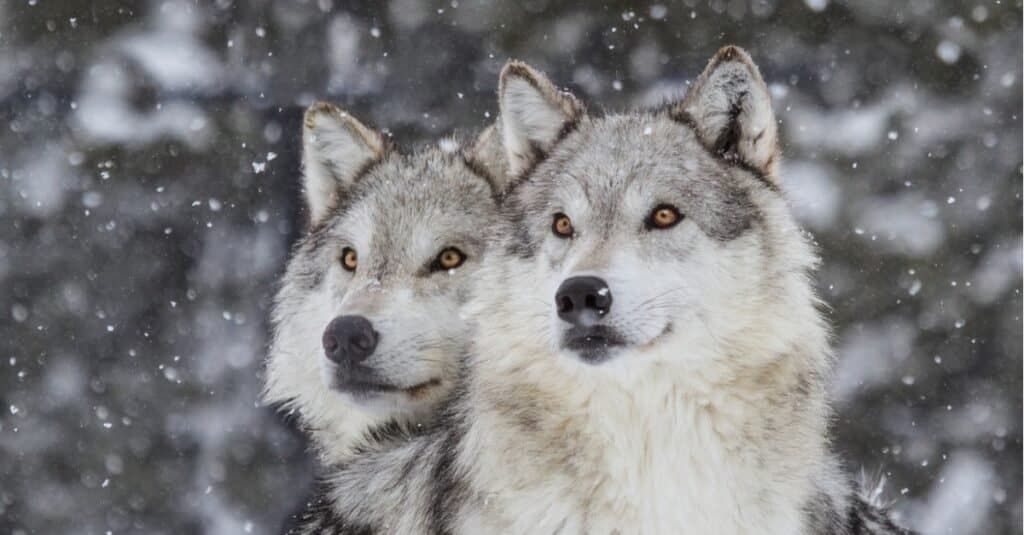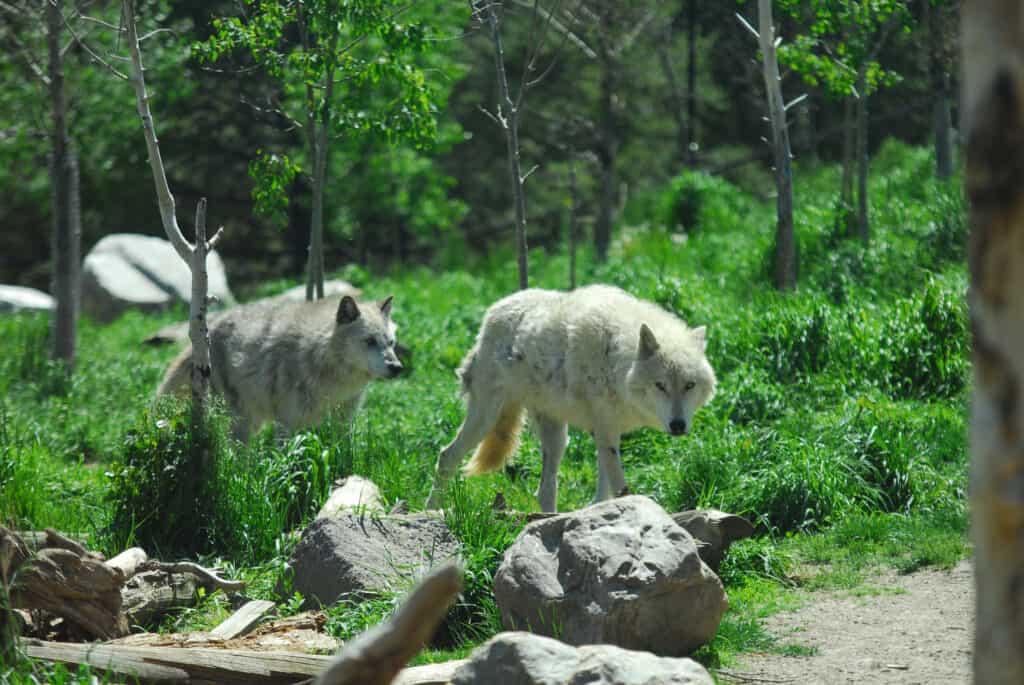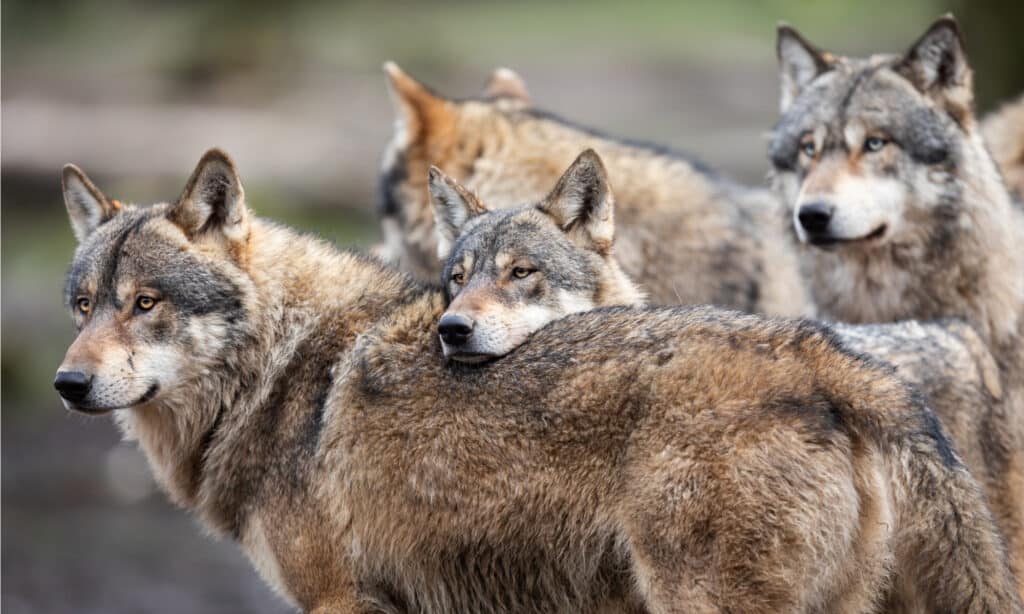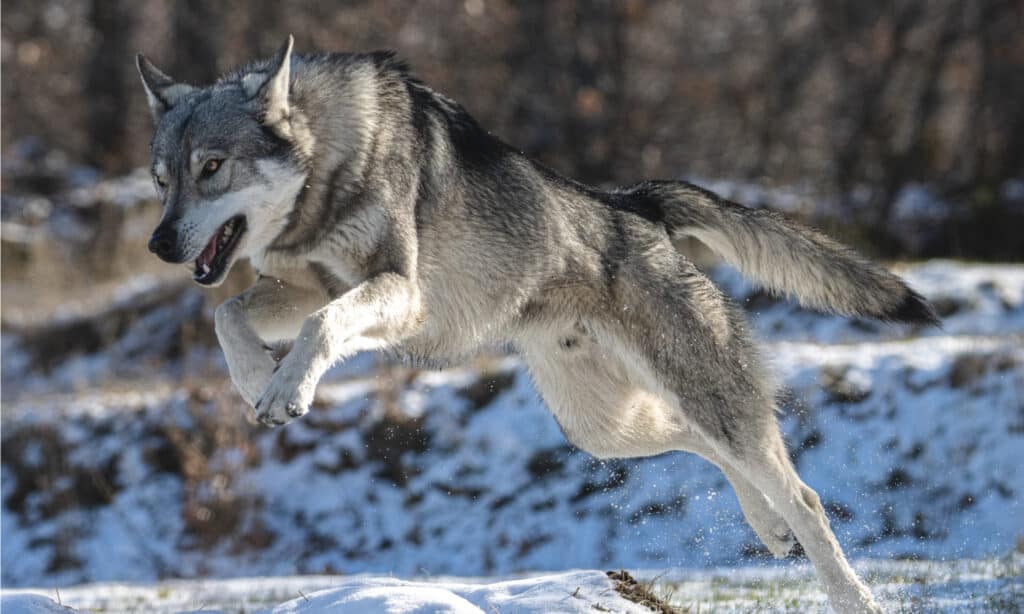Studies show that it takes an average of four wolves to bring down an elk, but this wasn’t the case for one of Yellowstone’s alpha wolves.
While she is no longer living, Yellowstone had an alpha wolf that caused quite a commotion in the greater Yellowstone community, especially among hunters in the area.
But what made this alpha wolf so famous, and what exactly happened to her? In this article, we will address everything there is to know about one of Yellowstone’s alpha wolves, notorious around the world for her accomplishments and what she offered researchers.
Learn about her rise to power and her tragic story’s end now!
One of the Most Famous Wolves in Yellowstone National Park

Wolf 832F was observed taking down fully grown elk on her own, on multiple occasions.
©iStock.com/rogertrentham
Gaining worldwide media attention after her death in 2012, Wolf 832F was one of Yellowstone’s alpha wolves. Also known as Wolf O-Six or 06 for her birth year in 2006, this female wolf became alpha of Lamar Valley by her third birthday.
Given the fact that the Lamar Valley is one of the best spots in all of Yellowstone to view wolves, she gained ample attention and became quite the “rock star” in the park.
Yellowstone Park Rangers collared 06 early on for tracking and research purposes. They were not disappointed. Studying her movements quickly revealed that she was the alpha wolf of her very small pack. Composed of Wolf 832F and two male wolf brothers, 06 led her pack with ruthless efficiency and grace, according to Park Rangers.
Not only did she mate with both brothers to give birth to multiple litters- but she also became the primary caregiver for her entire pack.
While the brothers meant well, many observers noticed the male wolves playing more than they cared to hunt. Once 06 gave birth and trusted her pack to watch her young, she ventured off on her own to hunt solo.
Wolf 832F was observed taking down fully grown elk on her own, on multiple occasions. Wolves do not do this unless they are desperate, in Yellowstone or anywhere else in the world, as elk pose a huge threat to their safety and wellbeing. A wolf can be easily injured by an elk. But 06 developed a particular hunting style that allowed her to go it alone!
What Happened to Wolf 832F, or 06?

After her pack was displaced from the Lamar Valley, Wolf 832F ventured roughly 15 miles east, outside of the protection of Yellowstone.
©MedstockPhotos/Shutterstock.com
After earning Yellowstone National Park plenty of additional media attention and funding from tourists flocking to see her, 06 met her end in 2012. Depending on the time of year, it is legal for residents in Idaho, Wyoming, and Montana to kill wolves, should they choose to roam outside of Yellowstone National Park.
After her pack was displaced from the Lamar Valley, Wolf 832F ventured roughly 15 miles east. This was outside of the protection of Yellowstone. She was legally shot and killed by a hunter, despite her wearing a GPS-enabled research collar. Given her distinctive features and fame, many wolf advocates wonder if she was shot purposefully.
She wasn’t the only wolf legally shot during this year. Her occasional mate, one of the two brothers previously mentioned, was shot just a few weeks prior to her. Yellowstone Park Rangers began to wonder about these deaths, especially when half of the wolves legally shot during this hunting season had tracking collars on at the time.
No matter the reason for her passing, 06 made a mark on the world and on Yellowstone National Park. She led to many fascinating discoveries and research for Yellowstone’s alpha wolves, despite her meeting a potentially untimely end.
The research continues in Yellowstone National Park, with wolves like 832F to thank for our ongoing understanding of this elusive species!
How Many Wolf Packs Currently Live in Yellowstone National Park?

It is rare to see a lone wolf, especially one capable of hunting elk solo- this ability seems reserved for only the strongest of alpha wolves, like 06!
©AB Photographie/Shutterstock.com
The park was established by the Yellowstone National Park Act of 1872. But now outdated ideas of “predator control” led to the extermination of the wolf population, through means such as poisoning, by park caretakers until the early 20th century.
The Endangered Species Act was passed in 1973 and between 1995 and 1996, 31 gray wolves were relocated to Yellowstone from Western Canada as part of an attempt to rebuild the destroyed population. Conservation efforts remain complex and challenging, but park officials continue to monitor the health and outlook of the species.
Currently, Yellowstone National Park has an estimated 8 distinct wolf packs inside of park limits. While these packs are constantly fluctuating based on territory and natural causes, there are nearly 100 wolves that reside in the park itself, and over 500 in the greater Yellowstone ecosystem. It is rare to see a lone wolf, especially one capable of hunting elk solo- this ability seems reserved for only the strongest of alpha wolves, like 06!
But if there are so many wolves in Yellowstone National Park, where can you expect to see them if you plan on visiting?
Where Can You See Wolves in Yellowstone National Park?

Currently, Yellowstone National Park has an estimated 8 distinct wolf packs inside of park limits.
©Sergijimenez/Shutterstock.com
Besides geysers, Yellowstone National Park is arguably most famous for its wolves and bison. You can see both of these majestic animals in Hayden Valley and Lamar Valley. This is especially true should you choose to brave Yellowstone during the harsh winter months. Wolves are consistently out hunting during this time of year, as food becomes more scarce.
If you aren’t confident about finding wolves on your own, there are many different guided wildlife tours you can participate in for an additional fee. Using GPS collars and expert knowledge, you may be more likely to witness one of these beautiful apex predators on a tour!
10 Facts About Wolf Packs in Yellowstone National Park

Grey wolf from the Wapiti Lake Pack getting ready to cross the road in Yellowstone National Park.
©iStock.com/mtnmichelle
Yellowstone National Park is home to several wolf packs, and the reintroduction of wolves in the park has had a profound impact on the ecosystem.
Here are 10 fascinating facts about wolf packs in Yellowstone National Park:
- Reintroduction: Wolves were reintroduced to Yellowstone in 1995 after being absent for several decades.
- Pack Structure: Wolf packs in Yellowstone are comprised of a breeding pair, or alpha wolves, and their offspring.
- Territory: Each pack claims a territory that can range from 50-150 square miles.
- Hunting: Wolf packs hunt in packs and primarily feed on elk and bison, but also prey on smaller animals like deer and beavers.
- Communication: Wolves communicate with each other through vocalizations, body language, and scent marking.
- Social Structure: Wolf packs are highly social animals, and pack members engage in behaviors such as grooming and play.
- Alpha Status: The alpha wolves in a pack are the dominant individuals and play a key role in maintaining order within the pack.
- Reproduction: Wolf packs typically produce litters of 4-6 pups each year.
- Adaptation: Wolves in Yellowstone have adapted to their environment and are able to thrive in a range of habitats.
- Ecological Impact: The reintroduction of wolves in Yellowstone has had a positive impact on the ecosystem, helping to regulate the populations of prey species and maintain a balanced food chain.
These facts provide a glimpse into the complex and fascinating world of wolf packs in Yellowstone National Park. Observing and studying these wolves provides important insights into the behavior and ecology of this keystone species.
The photo featured at the top of this post is © Paul Aparicio/Shutterstock.com
Thank you for reading! Have some feedback for us? Contact the AZ Animals editorial team.







